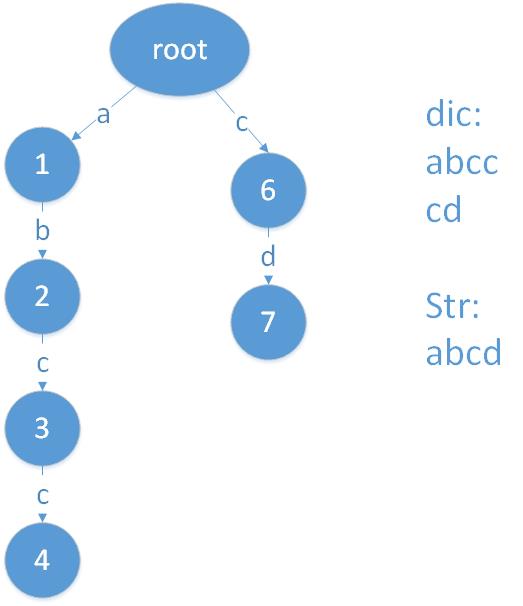问题描述:
给定N个字符串组成的一个词典 和 一个长为L的字符串S , 求S中是否存在词典中的字符串。
解决方法:
之前文章写过Trie树的方法记录一个词典,如果使用Trie树记录了词典中的所有词条,最长的词条为M,从前到后枚举S的每个位置,以当前位置为起点,使用Trie树进行比较,就可以判断是否存在。复杂度是O(M*L)。
是否存在时间复杂度更低的方法?首先,我们找上面方法的冗余比较:
比如下面的例子:
| 序号 | 1 | 2 | 3 | 4 |
|---|---|---|---|---|
| str | a | b | c | d |
| dic | a | b | c | ? |
在第四个位置处不匹配,此时移时要移动dic 到序号2,并从头开始比较:
| 序号 | 1 | 2 | 3 | 4 |
|---|---|---|---|---|
| str | a | b | c | d |
| dic | ? |
不匹配,再次移动:
| 序号 | 1 | 2 | 3 | 4 |
|---|---|---|---|---|
| str | a | b | c | d |
| dic | c | d |
成功找到。
其实,第二个位置的匹配是冗余的,因为第一次匹配过程中知道str[1~3] = dic[1~3], 也就是知道了str[2] = dic[2] = b, 而dic[1]
≠
b 所以在第一次比较中就已经可以预测到第二次比较是不成功的。
这部分类似KMP算法,每次不匹配的时候,不是从头开始比较,而是移动模式串。
如下图:

注:没有全部添加。
在Trie树的基础上,添加一些边,使得在每个节点处对于每个字符都有一个对应的出边。
要添加这些边,如上图现在要添加节点4的出边,首先已经有了字符为’c’的出边,要添加a, b, d 三条出边。首先找到节点4对应字符串“ab”在Trie树中的最长后缀节点,观察可得为2,就可以添加4–a–>1, 4–b–>2, 4–d–>0 三条边。
我们只需要知道当前节点n对应的最长后缀节点trie(n),如果trie(n)的对所有字符都有一个出边,我们就可以补充上当前节点n缺少的边。
trie(n)节点所在树的层数一定小于n所在树的层数,可以使用广度优先搜索,保证trie(n)的所有边已经添加。
现在问题是求最长后缀节点trie(n),回忆在KMP算法中的next数组递归求解过程。这里我们首先找到n的父节点f, 且存在f –c–>n这条边,我们已知f的最长后缀节点trie(f),然后再找到trie(f)–c–>P 这条边,这样就找到了trie(n) = P。
代码如下:
#include <cstdio>
#include <cstring>
#include <queue>
enum{maxm= 1000000+5, maxn = 1000+5};
struct Node{
int next[26];
int trie;
bool leaf;
};
Node tree[maxm];
int tNum = 0;
char s[maxm];
void add()
{
int rt, i;
for(rt =0, i=0; s[i]; rt = tree[rt].next[s[i]-'a'], i++)
{
if (!tree[rt].next[s[i]-'a'])
tree[rt].next[s[i]-'a'] = tNum++;
}
tree[rt].leaf = true;
}
std::queue<int> q;
void buildTree()
{
tree[0].trie = 0;
for (int i=0; i< 26; i++)
{
int rt = tree[0].next[i];
if (rt)
{
tree[rt].trie = 0;
q.push(rt);
}
}
while(!q.empty())
{
int rt = q.front();
q.pop();
// !!! 不要漏掉,
if (tree[tree[rt].trie].leaf)
tree[rt].leaf = true;
for (int i=0; i< 26; i++)
{
int trie = tree[tree[rt].trie].next[i];// 与KMP 不同, next 是已知的不需要循环查找
int ch = tree[rt].next[i];
if (ch)
{
tree[ch].trie = trie;
q.push(ch);
}else{
tree[rt].next[i] = trie;
}
}
}
}
bool find()
{
if (tree[0].leaf)
return true;
int j =0;
for (int i=0; s[i]; i++)
{
j = tree[j].next[s[i]-'a'];
if (tree[j].leaf)
return true;
}
return false;
}
int main()
{
//freopen("in.txt", "r", stdin);
int w;
scanf("%d", &w);
memset(tree, 0, sizeof(tree));
tNum = 1;
while(w--)
{
scanf("%s", s);
add();
}
buildTree();
scanf("%s", s);
printf("%s\n", find()? "YES":"NO");
return 0;
}
1,第0层的trie = 0;























 540
540

 被折叠的 条评论
为什么被折叠?
被折叠的 条评论
为什么被折叠?








